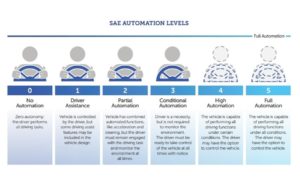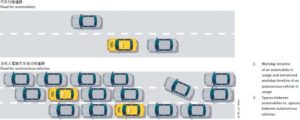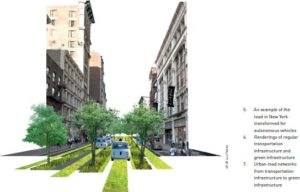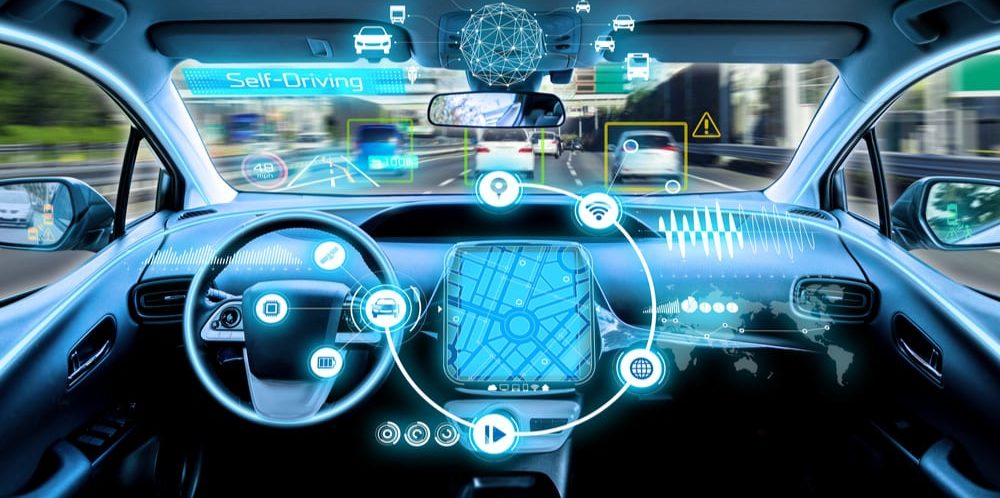Many have heard about the benefits of autonomous vehicles and how these vehicles are the future in our society. Autonomous vehicles (AVs) is a technology created to help alleviate the driving load of the driver partially or completely. Many people believe that AVs can only benefit the driver on the road, however this is not true. “Autonomous vehicle technology, in a rapid development, is leading to a transportation revolution,” being applied to all types of transportation such as air, rail, and sea type vehicles.
The idea of having autonomous vehicles has been traced back to the 1930’s. Around that time period, people were finding ways to make roads safer due to the many accidents caused by normal vehicles. One of the earliest ideas of an autonomous vehicle system was created by an American designer, Norman Bel Geddes. He envisioned a similar system like what the trains had, by using, “trench-like lanes that would keep cars apart in their own tracks.” When the vehicle is on the “track”, the autonomous system will kick in and drive the vehicles by itself. As the years went by, the autonomous vehicle system improved by utilizing cameras and sending its data to a computer. One of the vehicles that used an autonomous system and was successful was the aircraft. The introduction of an autonomous system on aircraft meant that the pilot can fly more efficiently thus reducing the use of fuel which made commercial flight cheaper, thus making it more affordable to people to travel.
The autonomous system has different levels to in and they are all based on how much input it needs from humans. According to the UCSUSA, there are five levels of autonomous systems. Level five of autonomy has the human driver have no input at all and the vehicle makes all the decisions for all types of scenarios. The level five of autonomous, is the level we are trying to accomplish. Right now, there are vehicles that are level five, but has not been set out to the public due to the government wanting more security on these vehicles before the masses have access to these vehicles. The main goal of an autonomous system is to reduce the amount of input required by a human driver to a vehicle.
As previously discussed, AVs help the driver alleviate its load while driving. In its early stage, AVs supported the driver by giving warnings to the driver and having the driver make the decision. Then AVs upgraded to partially taking control of the vehicle but still having the driver having control. Just recently, AVs now have total control of the vehicle and the driver has no control of the vehicle, the system in the vehicle makes the decision for the driver. By allowing AVs having total control over the vehicle, there is a less of a chance of a collision of occurring with another vehicle. Since AVs makes decision based on data collected around them, there is a less of a chance of an accident of occurring. According to the National Highway Traffic Safety Administration, “94 percent of accidents are related to human error.” “AVs are predominantly viewed as a positive improvement to current road safety conditions as they eliminate human error,” thus making them safer for other drivers on the road as well as pedestrians on the sidewalk.
The most common and popular benefit that most people associate AVs with is the one we just discussed, alleviating the driver’s load. This however, is not the only benefit AVs have, this is just the tip of the iceberg. If we adopt the idea of having AVs on our roads, we can greatly improve the environment. AVs are mostly associated with electronic vehicles; however normal combustion vehicles can also be AVs. AV is only a technology, not a type of vehicle and we can use this technology and implement it into any other vehicle we have now. By using the AV technology on our combustion engine vehicles, we can greatly reduce the emissions our combustion vehicles produce. This is possible since AVs will take the most fuel-efficient route thus reducing the amount of fuel burned and reducing the emissions combustion vehicles emit. Using AVs on combustion vehicles is not the most efficient way of utilizing the technology. For AVs to have a greater effect on the environment, most AVs must be electrically powered in order to, “render a more efficient and less carbon-intensive transportation system.”
AVs can further benefit our society by reducing the size of the roads. When using an AV, the AV calculates it route through data from other vehicles in order to determine the most efficient route. “Autonomous vehicle networks can be completely operated by cloud computing that would optimize the real traffic volume of each road section,” which will help alleviate most traffic congestion on the roads. Since AVs operate through AVs surrounding it, the clearance between the two AVs can be greatly reduce from traditional human operated vehicles. By reducing the space between two vehicles, we can reduce a traditional two land road into a three-lane road but, still maintain the size of the two-lane road. If we reduce the number of lanes a road takes up, we can increase the amount of free space in a city. With the new vacant space, “we can accommodate activities such as outdoor restaurants, markets, citizen sports, and concerts.”
By reducing the space between two vehicles, we can reduce a traditional two land road into a three-lane road but, still maintain the size of the two-lane road. If we reduce the number of lanes a road takes up, we can increase the amount of free space in a city. With the new vacant space, “we can accommodate activities such as outdoor restaurants, markets, citizen sports, and concerts.”  Furthermore, we can grow vegetation in those free empty spaces in busy cities bringing back lost vegetation from all the construction of buildings. Having vegetation grow where the roads once were, will dramatically have a positive benefit to us as a whole society, since the air quality in cities aren’t that great as of now.
Furthermore, we can grow vegetation in those free empty spaces in busy cities bringing back lost vegetation from all the construction of buildings. Having vegetation grow where the roads once were, will dramatically have a positive benefit to us as a whole society, since the air quality in cities aren’t that great as of now.
AVs also introduce the idea of sharing a vehicle instead of privately owning one. If most people agree with the idea of having shared vehicles, then the need of having parking lots would dramatically decrease. There will be no need for huge spaces for parking lots anymore thus allowing the construction of other buildings. With the free space, cities can build more apartment complexes in order to alleviate the problem of overcrowded cities. As more and more apartments get built, the price of living in a city will lower making it more affordable to live in a major city.
Having AVs in our society can also help change our lifestyles and health overall. AVs will allow the driver to relive him or herself by, “removing the stressful element of driving the vehicle and limiting the amount of time spent in congested traffic conditions.” The AV will do the driving for the person without any inputs from that person. Secondly, it will connect us as a society. As you get older, the time you spend outside decreases due to not being able to drive or walk far distances. “AVs are predicted to improve accessibility for differently abled populations, reduce isolation, improve social connectivity and potentially improving independent mobility for populations who are unable to or can no longer drive,” such as the older generation. According to the UCSUSA, autonomous vehicles will benefit the elderly and disabled people, since AVs won’t need any input from the driver to get to their desired destination.
As with many new technologies, there critics who are totally against the idea and disadvantages that we may not know of at the moment. Many critics say that AVs does not really make roads safer instead, they make it even more dangerous then they are now. They don’t have confidence in the system in recognizing certain situations thus making the driver of the AV get involve in an accident. There are also some security issues with AVs that many critics are skeptical of. Many argue that since AVs are controlled by a computer, someone can easily hack into the system and take control over the car. Also, since AVs must store a lot of personal data of the driver, many are afraid that data may get leaked to the public. Finally, one of the most argued point for AVs is that it is going to ruin the economy.
Let’s explain how AV’s may ruin the economy. Since many adopters of AVs are for the idea of having shared AVs and a common public transportation, this will mean thousands of people will become unemployed if AVs are used worldwide. All taxi companies would be out of business since AVs would take over as the prefer transportation. According to the Auto Insurance Center, “This could have a negative impact on the unemployment rate and the economy.” However, this may not to be the case. This hasn’t still been proven and in contrary AVs would create more jobs. If AVs are adopted, most countries will require a safety driver to monitor the AVs’ actions. The typical taxi driver can take the position of a safety driver, with some additional training. AVs will also need people to do daily maintenance and inspections since the AVs will be running nonstop.
As for the security issue, many software engineers are still developing ways to improve the security of AVs. The AV system we have now is fairly a new system we have just invented, and it is obvious the security of this new technology isn’t the best. Even though it may not be the most “secured” by most critics, many AVs have been running throughout many countries and there hasn’t been any issues with someone hacking the system and taking control over the vehicle.
Another point critic is arguing about AVs is that AVs are for the wealthy and aren’t meant for the masses. This is true, 5 years ago. Before, AVs went for more than $100,000 due to the components of the AV system, at that time, being very expensive. However, now in 2019, the price for an autonomous vehicle has dramatically decreased.  Thanks to Tesla’s Model 3, a fully capable autonomous vehicle goes for $35,000. Many people, including me, thought that AVs were very expensive and only the very wealthy can afford these luxury vehicles. This however is false, since a normal combustion engine car, brand new, will go for the same amount as an autonomous vehicle.
Thanks to Tesla’s Model 3, a fully capable autonomous vehicle goes for $35,000. Many people, including me, thought that AVs were very expensive and only the very wealthy can afford these luxury vehicles. This however is false, since a normal combustion engine car, brand new, will go for the same amount as an autonomous vehicle.
AVs are still a very new technology that can get better. As time goes on and science improves, the components to make an AV will become cheap thus allowing AVs available to the middle and lower class. All the issues that critics claim AVs have, may soon be eliminated as engineers continue to work on it and improve the system’s security and system. It would be nice to have an AV in our everyday lives since it may one day prevent a fatal accident. In a conducted interview with the Public Safety Department of City College, they have seen many students of the college walk across the street, even if the light hasn’t changed for them to walk, and cars would have to stop for them even if the car has the right of way. The Public Safety Department has said that it would be beneficial to have AVs since the system can make the decision faster than a human and can prevent an accident from ever occurring on their campus.
One of the obstacles for AVs at the moment is the government and the people. Most people don’t have enough information about AVs and think they are unsafe since they are a vehicle controlled by a computer. In order for AVs to be adopted everywhere, the public’s view on AVs has to first change. Secondly, the government is another factor why AVs aren’t worldwide just yet. Most governments are still skeptical about AVs being let loose on the roads. They want AVs to have a better security system before they are allowed to fully be autonomous.
In order for AVs to be adopted everywhere, the public’s view on AVs has to first change. Secondly, the government is another factor why AVs aren’t worldwide just yet. Most governments are still skeptical about AVs being let loose on the roads. They want AVs to have a better security system before they are allowed to fully be autonomous.
Autonomous vehicles will make lives worldwide so much easier and safer. With the reduction of accidents on the road, many lives can be saved, and traffic can be less congested. There are many opportunities AVs can bring to the table and it all depends on us and how we use it. There may be some issues and disadvantages to AVs as time goes on but, as technology improves so will AVs and it will become safer. All of the benefits that AVs has outweighs the disadvantages and all the disadvantages it has can be fixed as its system improves over time.
Work Site
Dean, Jennifer, Alexander J. Wray, Lucas Braun, Jeffrey M. Casello, Lindsay McCallum, and Stephanie Gower. “Holding the keys to health? A scoping study of the population health impacts of automated vehicles.” BMC Public Health 19, no. 1 (2019). Gale Academic Onefile (accessed October 14, 2019). https://link-gale-com.ccny-proxy1.libr.ccny.cuny.edu/apps/doc/A600224930/AONE?u=cuny_ccny&sid=AONE&xid=35cddcba.
Yadan, Luo, et al. “FROM TRANSPORTATION INFRASTRUCTURE TO GREEN INFRASTRUCTURE–ADAPTABLE FUTURE ROADS IN AUTONOMOUS URBANISM.” Landscape Architecture Frontiers, vol. 7, no. 2, 2019, p. 92+. Gale Academic Onefile, https://link-gale-com.ccny.proxy1.libr.ccny.cuny.edu/apps/doc/A598128834/AONE?u=cuny_ccny&sid=AONE&xid=1afb53bd.
Rowthorn, Michael. “How Should Autonomous Vehicles Make Moral Decisions? Machine Ethics, Artificial Driving Intelligence, and Crash Algorithms.” Contemporary Readings in Law and Social Justice, vol. 11, no. 1, 2019, p. 1+. Gale Academic Onefile, https://link.gale.com/apps/doc/A596319036/AONE?u=cuny_ccny&sid=AONE&xid=1d5707b7.
Robinson, Jessie “4 Benefits of Autonomous Vehicles You May Not Have Considered”
https://www.fleetio.com/blog/4-benefits-of-autonomous-vehicles
MADRIGAL, ALEXIS C. “7 Arguments Against the Autonomous-Vehicle Utopia” https://www.theatlantic.com/technology/archive/2018/12/7-arguments-against-the-autonomous-vehicle-utopia/578638/
UCSUSA “Maximizing the Benefits of Self-Driving Vehicles” Feb 3, 2017 https://www.ucsusa.org/resources/maximizing-benefits-self-driving-vehicles
Weber, Marc “WHERE TO? A HISTORY OF AUTONOMOUS VEHICLES” May 08, 2014 https://computerhistory.org/blog/where-to-a-history-of-autonomous-vehicles/?key=where-to-a-history-of-autonomous-vehicles



